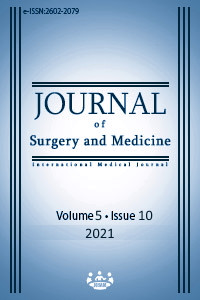The impact of MRI findings in the liver in the diagnosis of pediatric Wilson’s disease
Keywords:
Wilson disease, Magnetic resonance imaging, Liver, CeruloplasminAbstract
Background /Aim: Wilson's Disease (WD) is one of the genetic diseases that can be successfully managed with early diagnosis and treatment. There is no single test used in its diagnosis; therefore, the diagnosis is made by laboratory and clinical findings, as well as genetic analysis results. This study aimed to describe the magnetic resonance imaging (MRI) findings in the livers of pediatric patients with WD and evaluate the relationship between serum ceruloplasmin, 24-hour urinary copper values, and MRI findings. Methods: A total of 35 patients with WD younger than 18 years of age were included in this cohort study. Qualitative and quantitative parameters were evaluated in MRI. The qualitative parameters included parenchymal nodule, contour irregularity, honeycomb pattern, ascites, and increased periportal thickness. The quantitative parameters were splenomegaly and the ratio of the caudate lobe to the right lobe (CL/RL). All patients were classified according to the absence or presence of qualitative and quantitative parameters on MRI. The serum ceruloplasmin levels and 24-hour urinary copper values were evaluated according to the scoring system developed at the Eighth International Meeting on Wilson disease in Leipzig, in 2001. All qualitative and quantitative MRI findings were compared among patients with high and low serum ceruloplasmin levels and 24-hour urinary copper values. Results: Ascites and splenomegaly were the most common findings, seen in 17 (48.6%) and 19 (52.7%) patients, respectively. Twenty-eight (80%) patients had normal caudate-lobe to the right-lobe (CL/RL) ratio in MRI. The serum ceruloplasmin levels in patients with parenchymal nodules, irregular liver contours, ascites in the abdomen, increased periportal thickness and splenomegaly were significantly lower than those without these findings (P<0.05). The 24-hour urinary copper values in patients with ascites and increased periportal thickness were significantly higher than in those without (P<0.05). Conclusion: In case of nonspecific liver MRI findings such as parenchymal nodules, irregular liver contours, ascites in the abdomen, increased periportal thickness, and a normal caudate to right-lobe (CL/RL) ratio in a pediatric patient with decreased serum ceruloplasmin and increased 24-hour urinary copper values, WD should be considered among the causes of chronic liver disease.
Downloads
References
European Association for Study of Liver (EASL) Clinical Practice Guidelines: Wilson’s disease. J Hepatol. 2012;56:671–85.
Ala A, Walker AP, Ashkan K, Dooley JS, Schilsky ML. Wilson’s disease. Lancet. 2007;369:397–408.
Bandmann O, Weiss KH, Kaler SG. Wilson’s disease and other neurological copper disorders. Lancet Neurol. 2015;14:103–13.
Roberts EA, Schilsky ML. American Association for Study of Liver Diseases (AASLD). Diagnosis and treatment of Wilson disease: an update. Hepatology. 2008;47:2089-111.
Akhan O, Akpinar E, Karcaaltincaba M, Haliloglu M, Akata D, Karaosmanoglu AD, et al. Imaging findings of liver involvement of Wilson’s disease. Eur J Radiol. 2009;69:147–55.
Cheon JE, Kim IO, Seo JK, Ko JS, Lee JM, Shin CI, et al. Clinical application of liver MR imaging in Wilson’s disease. Korean J Radiol. 2010;11:665–72.
Akhan O, Akpinar E, Oto A, Köroglu M, Ozmen MN, Akata D, et al. Unusual imaging findings in Wilson’s disease. Eur Radiol. 2002;12:S66–9.
Tokuhisa Y, Shimizu M, Yachie A. Honeycomb appearance of the liver in Wilson’s disease. Clin Gastroenterol Hepatol. 2012;10:A25.
Kozic D, Svetel M, Petrovic I, Sener RN, Kostic VS. Regression of nodular liver lesions in Wilson’s disease. Acta Radiol. 2006;47:624-7.
Vargas O, Faraoun SA, Guerrache Y, Woimant F, Hamzi L, Boudiaf M, et al. MR imaging features of liver involvement by Wilson disease in adult patients. Radiol Med. 2016;121:546-56.
Awaya H, Mitchell DG, Kamishima T, Holland G, Ito K, Matsumoto T. Cirrhosis: modified caudate-right lobe ratio. Radiology. 2002;224:769–74.
Konus OL, Ozdemir A, Akkaya A, Erbas G, Celik H, Işik S. Normal liver, spleen, and kidney dimensions in neonates, infants, and children: evaluation with sonography. AJR Am J Roentgenol. 1998;171:1693–8.
Manolaki N, Nikolopoulou G, Daikos GL, Panagiotakaki E, Tzetis M, Roma E, et al. Wilson disease in children: analysis of 57 cases. J Pediatr Gastroenterol Nutr. 2009;48:72-7.
Mergo PJ, Ros PR, Buetow PC, Buck JL. Diffuse disease of the liver: radiologic-pathologic correlation. Radiographics. 1994;14:1291-307.
Cope-Yokoyama S, Finegold MJ, Sturniolo GC, Kim K, Mescoli C, Rugge M, et al. Wilson disease: histopathological correlations with treatment on follow-up liver biopsies. World J Gastroenterol. 2010;16:1487-94.
Vogl TJ, Steiner S, Hammerstingl R, Schwarz S, Kraft E, Weinzierl M, et al. MRT of the liver in Wilson’s disease. Rofo. 1994;160:40–5.
Colli A, Fraquelli M, Andreoletti M, Marino B, Zuccoli E, Conte D. Severe liver fibrosis: accuracy of US for detection-analysis of 300 cases. Radiology. 2003;227:89–94.
Ko S, Lee T, Ng S, Lin J, Cheng Y. Unusual liver MR findings of Wilson’s disease in an asymptomatic 2-year-old girl. Abdom Imaging. 1998;23:56–9.
Roberts EA, Schilsky ML. American Association for Study of Liver Diseases. Diagnosis and treatment of Wilson disease: an update. Hepatology. 2008;47:2089–111.
Dong Y, Wang R.M, Yang G.M, Yu H, Xu WQ, Xie JJ, et al. Role for Biochemical Assays and Kayser-Fleischer Rings in Diagnosis of Wilson’s Disease. Clinic Gastroentrol Hepatol. 2020;S1542-3565:30751-5.
Downloads
- 208 345
Published
Issue
Section
How to Cite
License
Copyright (c) 2021 Güleç Mert Doğan, Şükrü Güngör, Gökalp Okut, Sait Murat Dogan, Fatma İlknur Varol, Ahmet Sığırcı, Sezai Yılmaz
This work is licensed under a Creative Commons Attribution-NonCommercial-NoDerivatives 4.0 International License.
















